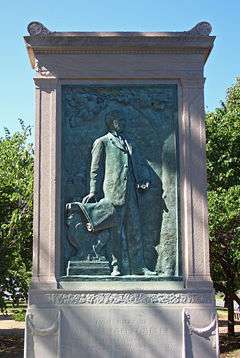August Meyer

August R. Meyer (August 20, 1851 – December 1, 1905) was a mining engineer, founding organizer of Leadville, Colorado, and developed the park and boulevard system for Kansas City, Missouri as first president of the Commission of Parks.
Background
August Robert Meyer was born in St. Louis, Missouri on August 20, 1851. His father was Heinrich Peter Meyer (1815–1864) and his mother was Anna Catharina Margaretha Kraft (1812–1898). They were residents of Hamburg, Germany, and immigrated to the United States before their marriage on July 29, 1844, in St. Louis, Missouri. Heinrich Meyer was an enterprising man: by 1850, the Federal Census shows he was manufacturing lard oil and boneblack. Later, he partnered with Jacob Tamm (1815–1893), founding a company which soon became the St. Louis Woodenware Company, a highly productive and profitable corporation which existed until 1907. (Tamm may have been a long-time friend of Heinrich Meyer; they were both born in Hamburg, Germany, in 1815.) After Heinrich Meyer died, (listed as one of the wealthiest manufacturers in St. Louis at his death,) Anna Meyer sent her son to Europe to begin his education. August Robert Meyer studied at the College of the Canton of Zurich, Switzerland, and after graduating, began a course of study at the School of Mines in Freiberg, Germany, graduating in 1870.
August R. Meyer returned to the United States, and to St. Louis, Missouri, in 1873. He worked for a coal mining operation in Illinois for one year, and then went to Colorado in 1874. In 1875, he started an ore-crushing mill at Alma, Colorado and struck it rich in the Colorado Silver Boom. He and other investors including Horace Austin Warner Tabor founded Leadville and Fairplay, Colorado.[1] His home in Leadville, called Healy House, is on the National Register of Historic Places and is a museum.
In 1881, Meyer moved to Kansas City, Missouri. He established the Kansas City Smelting and Refining Company in the Armourdale section of Kansas City, Kansas. The company was taken over by the Guggenheim-owned American Smelting and Refining Company, and he joined the board of directors. Later, he became president of United Zinc Company.[2]
In 1887, Meyer became inspired by the City Beautiful Movement and began pushing for a new park system in Kansas City, Missouri. In 1892, Mayor Benjamin Holmes appointed him president of the city's first park board. Meyer and Holmes hired George Kessler to design the extensive and noteworthy system.
Meyer's home, called "Marburg," was a three-story, 35-room Germanic castle on eight and one-half acres. After his death, Howard Vanderslice bought the house and estate and donated it to become the Kansas City Art Institute (where after a Wight and Wight addition) it is the school's administration building. It is now called Vanderslice Hall and is listed on the National Register of Historic Places.
Meyer died in Kansas City on December 1, 1905, at age 54. Meyer Boulevard is named to honor his great work to create the boulevard and park system in Kansas City. A bronze bas-relief sculpture by Daniel Chester French on an 18-foot (5.5 m) high Knoxville marble marker honoring Meyer was dedicated on 2 June 1909, four years after his death. The memorial is located at 10th and The Paseo in the parkway. The epitaph reads:
- "Houses and Shops Are Man's
- But Grass and Trees and Flowers
- Are God's Own Handiwork
- Undaunted, This Man Planned and Toiled
- That Dwellers in This Place
- Might Ever Freely Taste the
- Sweetest Delights of Nature."
